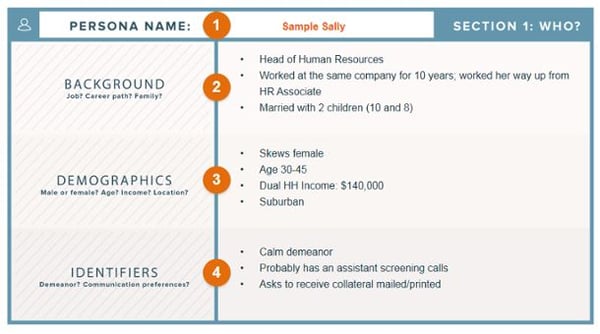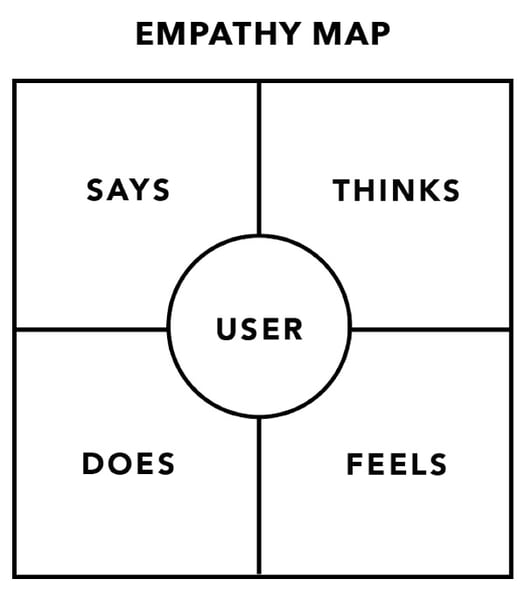As Drake's "In My Feelings" song tops the charts and Shiggy's viral "In My Feelings" Challenge continues to injure those seemingly desperate for online fame, I find myself in my feelings (go figure) about the concept of empathy.
First off, I question my empathy, or lack thereof, for those knowingly putting themselves in harm's way for a viral dance challenge. (Don't get me wrong, I love a good dance challenge - viral or otherwise... but I've digressed.) Secondly, the idea of being in one's feelings makes me think about how, as a Content Strategist, I am constantly in my feelings trying to channel the feelings of customers.
While this realization is probably just a glorified Inception cliché (i.e., something inside of something inside of another something), it is also a light-bulb moment for me when it comes to empathy marketing.
In other words...
Good content - good marketing - requires empathy.
While empathy marketing was the buzzword du jour many moons ago, I never really took the time to evaluate it as a real-world marketing strategy. Now, here I am, in my feelings about empathy in content marketing, so I've decided to do some research (another favorite pastime of a content marketer).

What Is Empathy?
According to good ol' Merriam Webster, empathy is defined as "the action of (or capacity for) understanding, being aware of, being sensitive to, and vicariously experiencing the feelings, thoughts, and experience of another."
Phew! Ok, let's break that empathy definition down a bit. Action: that means doing something. Capacity: that means having the ability to perform said action. But then, my next question is...
Is Empathy Conscious or Unconscious?
Is empathy a choice? Or does one's empathy simply kick in automatically? The answer is yes - to both. Psychologists define cognitive empathy as a kind of mental perspective taking, while emotional empathy is defined as a vicarious sharing of emotion.
I guess that's good news for humanity and for content marketing. You can consciously choose to exercise empathy. But how?
How to Practice Cognitive Empathy
The old adage about empathy is that you need to put yourself in someone else's shoes. Although this statement has been used so frequently that it has become cliché (much like an Inception moment), it really is a spot-on example of exercising empathy... with one caveat.
The key to empathy is remembering that it's not about how you would feel in the other person's shoes, but how the other person feels. To put yourself in someone else’s shoes is to consider the other person's perspective. To do so is called practicing cognitive empathy.
When we take on another person's perspective, we consciously choose to focus on "... understanding, being aware of, being sensitive to, and vicariously experiencing the feelings, thoughts, and experience of another." (Thanks again, Merriam Webster.)
While putting yourself in someone else's shoes might sound easy, it's not quite as simple as strapping on another person's pair of Nikes. It requires you to use critical thinking and set your own feelings aside.

For example, let's say you are a nonsmoking, nicotine gum marketer trying to put yourself in your customer's shoes. While you may feel for your customer in his/her struggle to quit smoking, you also might feel that smoking is a bad habit that is detrimental to one's health (which is why you personally don't smoke). However, you must put your personal feelings about smoking aside and practice cognitive empathy to understand your customer's mindset.
Consider that your customer is fighting a powerful addiction. While your customer likely realizes that smoking is unhealthy, he/she feels physically and/or emotionally compelled to smoke. He/she probably also feels ashamed, especially knowing the health consequences. In addition, he/she may feel alone and rejected by a predominantly nonsmoking society. When you focus on how your customer feels, does any part of you think a "smoking is a bad habit" marketing message is a good idea?
Probably not. Because, by considering the pull of addiction, as well as the feelings of shame and rejection that your customer is experiencing, you can cognitively empathize with him/her and understand that what your customer needs is support.
If you were merely being sympathetic, you wouldn’t think about the addiction and the rejection as much, because you, from a distance, would understand that smoking is bad for your health and that your customer will be much better off by quitting. But your customer doesn’t fully understand that right now. He/She has addiction and shame clouding his/her judgement and preventing him/her from seeking out support to quit smoking. So, if your content focused on smoking being disgusting or uncool, you would only be adding to your customer's feelings of rejection - and your marketing strategy would be off base.
To practice cognitive empathy in this situation (and all others) is to put your perspective aside and simply consider the other person's. When you can place yourself in your customer's shoes and identify how your customer feels in his/her situation, the way you communicate with him/her will change dramatically.
Like anything though, practice makes perfect. In that regard, empathy marketing seems legit: empathy and marketing are both skills that can be honed. So how does one execute an empathetic marketing strategy? The short answer is: thoughtfully. The long answer is...
How to Do Empathy Marketing
We've established that empathy requires you to put yourself in another's shoes, and that cognitive empathy requires you to consciously take on that person's perspective. Here's how to use those concepts to create an empathetic marketing strategy:
1. Develop Customer personas
To understand your customers and what appeals to them, you need to know who they are and what makes them tick. Developing customer personas involves asking and answering questions about your customers' background, demographics and key identifiers. Here is a snapshot of a sample customer persona from HubSpot:
 The more information you gather about your customers, the better. Follow this four-step process to create a buyer persona:
The more information you gather about your customers, the better. Follow this four-step process to create a buyer persona:
Use the information your collect to create your buyer persona to identify opportunities for creating empathetic marketing content.
2. Create Empathy Maps
A technique that's used widely across the agile and design communities, empathy mapping, can help you gain even deeper insight into who your customer is. Empathy mapping can also identify gaps in what you thought you understood about your customers, as well as bring to light things you didn't even know.
A traditional empathy map is split into four quadrants (says, thinks, does and feels), with the user or customer persona in the middle. Here's a basic empathy map template:

Start by thinking up a question you have for that persona. For example, what situation in his/her life would you want to better understand? Maybe it's the simple question of why he/she should buy your product or service.
With that question in mind, think about what your customer might say, think, do and feel. As best you can, try to project yourself into your customer's experience, then start to fill in the four quadrants of the empathy map with real, tangible, sensory experiences. For example, in the “says” section, try to write out your customer's thoughts as he/she would express them. But don’t put words into his/her mouth. The point is to truly understand and empathize with your customer's situation, so you can deliver a better, more strategic marketing message.
An empathy mapping exercise can be as simple or as complex as you want to make it. But the ultimate goal of the exercise is to more deeply understand and empathize with your customers. That way, you can build stronger customer relationships and create a marketing strategy with empathetic content that gets results.
3. Use What You've Learned
Now for the fun part... it's time to get creative and apply what you're learned to your content creation. Build your brand using tone and voice. Flex your interpersonal communication muscle and put your people skills on paper (or into pixels) to craft a truly empathetic marketing message.
While nonverbal cues are missing from any digital marketing message, you can use the insight you've gleaned from your customer persona and empathy mapping exercises to create content that fills in the nonverbal gaps and clearly shows your customers that, as a brand, you really "get" them.
Wondering what this looks like? Take, for example, Dove’s ‘Real Beauty Sketches’ video campaign in which the brand explored the difference between how others perceive us and how we perceive ourselves. The video - and its tagline, "You’re more beautiful than you think," - evoked such a powerful, emotional response that the video currently has more than 68 million views on YouTube. (And you'll notice that Dove's brand video doesn't even mention or show any of its products.)
But empathy marketing doesn't necessarily have to be touchy-feely. Especially if that kind of tone doesn't resonate with your customers. Empathy marketing just shows your customers you "get" them and can relate.
Here's another example of an empathetic video marketing campaign, one using humor that's geared toward travelers:
JetBlue's "Flight Etiquette" video was a funny PSA focusing on the world of flying and the uncomfortable experiences we all have while doing so. By poking fun at some of the common problems we encounter when traveling, JetBlue showcased its humorous brand voice while clearly conveying that they "get it."
I've given you some good examples of empathetic marketing in video content, but what about empathy in written marketing content, like in, say, a blog? Ask and you shall receive...
Every interaction with a customer presents an opportunity for a brand to show empathy. By focusing on the customer, your written blog content can also show that your brand "gets it." Here's a great use of empathy marketing in one of THAT Agency's own client's blogs:

Synergy Homes, a high-performance home builder in South Florida, is making a play to capture home buyers looking for affordable, energy-efficient new construction. The brand has long provided model floor plans and galleries of photos on its site, but with the Florida Homes blog, Synergy Homes has been inserting itself into the lives of energy- and cost-conscious Florida home buyers with a variety of content.
Posts like “How to Measure Air Leakage in a Home” may sound a little silly, but for Florida homeowners looking to add energy efficiency to their existing homes or upgrade by buying a more energy-efficient new home, these are the exact types of posts that are relevant to their lives. The user-friendly layout and fun visuals in the blog posts also help bring these stories to life.
But how do these blog posts illustrate empathy marketing? Providing free and useful tips helps Florida homeowners and home buyers identify opportunities to save energy and money - two things Synergy Homes understands are important to its customers.
Additionally, fans get to share their enthusiasm for the blog content through social media, helping Synergy Homes extend its reach while the brand helps its customers share their interests with friends and family.
Thus, the driving force behind each of these empathy marketing examples is a desire to create meaningful connections. Meaningful connections are forged through mutual understanding. Brands who show empathy in marketing show their customers they understand (and care about) them. And, in turn, customers understand (and care about) empathetic brands.
4. Revisit steps 1-3 regularly
The only certainties in life are death, taxes... and change. Perspectives change. Customers change. Your brand should change, or rather - evolve.
Be sure you're keeping your finger on the pulse of who your customer is right now (not who your customer was six months or a year ago). That way, your brand will continue to deliver marketing content that speaks to who your customer really is.
Empathy is Good for Business
In conclusion, any good marketing strategy should focus on making sure your products and services meet the needs of your customers. Marketers who do so successfully exercise empathy.
How exactly does one exercise empathy? Consciously. It's called cognitive empathy, and for some, it takes practice. Because cognitive empathy is a practice (some may say it's a marketing best practice), you can fine tune your empathy skills alongside your marketing strategy to create and distribute content that cultivates profitable, long-term relationships with your customers... and ultimately adds to the bottom line of your business.
Need help executing an empathetic marketing strategy for your brand? Contact the content marketing specialists at THAT Agency today.





.jpg)